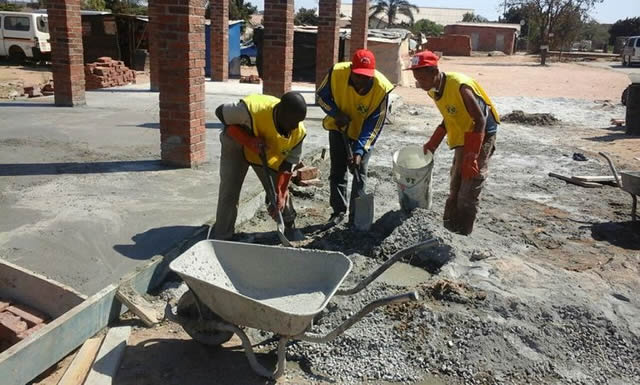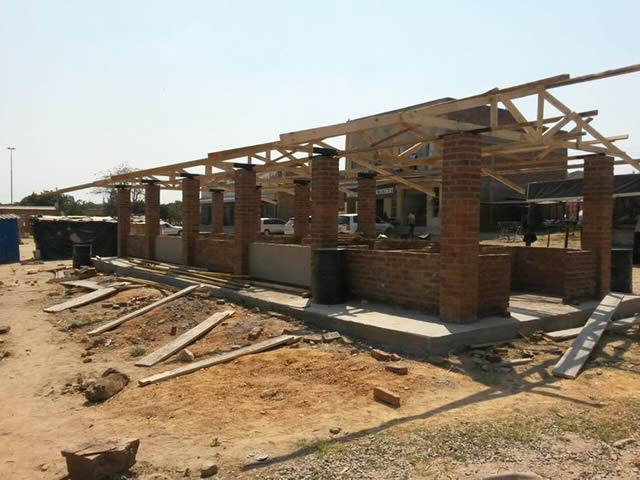Latter-Day Saints in empowerment drive


Members of the Church of Jesus Christ of Latter-Day Saints work at the Sunningdale Marketing Mall construction site
Musavengana Hove Features correspondent
Church of Jesus Christ of the Latter-Day Saints in Zimbabwe has embarked on a massive empowerment drive aimed at improving the health sector and small to medium enterprises in Zimbabwe.The radical denomination which is increasingly gaining currency in the country has built a colossal market hall in Sunningdale 3 which is expected to accommodate an estimated 20 small to medium scale businesses and refurbished Seke South Clinic in Chitungwiza whose threshold goes beyond its vicinity.
According to church sources, the ribbon cutting ceremony to mark the opening of the mall and the official handover of the refurbished clinic will be held in due course under the theme “Community Partnership”.
“Members of the Church of Jesus Christ of Latter-Day Saints’ voluntarily offered their talents, time, skills and services in constructing the mall from its initial phase until it was completed as part of the church’s Mormons Helping Hands Programme. The members further painted, landscaped and refurbished Seke Clinic in Chitungwiza,” reads a press statement from church whose headquarters is in Waterfalls, Harare.
The Herald Review understands the Mormons Helping Hands is priesthood directed church programme that provides organised opportunities for church members to give their time and talents to bless the destitute population.
The philanthropy programme gives church members the opportunity to beautify city streets, parks, schools, and recreational areas and in other ways, showing that the church is a friend to the community.
During a visit to Sunningdale 3 shopping centre, The Herald Review was ushered by a magnificent and towering marketing hall nearing completion with only the roof left to the thatched. The strongly reinforced pillars made of face bricks radiate strength and the invincibility of a trade centre which is gradually morphing into a premium commercial nucleus.
“We were told the marketing mall is going to benefit the needy here in Sunningdale. We are sure they are going to stick to their initial promise,” said a vendor operating adjacent to the site of the mall.
Public Affairs director for Zimbabwe Harare South Stake, Caroline Kuhudzai allayed fears that the facilities being currently built will benefit people who are connected to the church only.
“The activities are meant to provide community service and are not proselytising in nature. Each year the Church of Jesus Christ of Latter-Day Saints provides service to communities and other people (not of our faith) across the globe as part of the Church’s Mormon Helping Hands Programme.
“In 2014, the church here in Zimbabwe, partnered with Harare City Council and repainted the Harare Town House and had a clean up campaign with the council in the CBD. In the same year, we refurbished Highfields satellite clinic among other several projects that were done in Zimbabwe,” said Kuhudzai.
Mormonism in Zimbabwe
The birth of Mormonism in Zimbabwe is linked the missionary activities of Hubert Henry Hodgkiss. Oral tradition says he was baptised February 1, 1951, marking the first convert baptism in Southern Rhodesia.
Church documents also say his charismatic character and friendly nature allowed him to make great contributions to the growth of the church in the then Southern Rhodesia.
The literature also say that in the April 2013 general conference, Edward Dube was called to be a member of the First Quorum of the Seventy, making him the first General Authority of the Church from Zimbabwe.
“This was only the most recent of many firsts for Elder Dube. He was also the first native stake president, first native mission president, and first native Area Seventy from Zimbabwe,” reads the church document.
As the church continues to empower the destitute population in Zimbabwe through the word and charitable gestures, church sources say so are the number of congregants and the visibility of the denomination in the country and in the world at large.
“We have a membership of over 26 000 in Zimbabwe and over 15 million worldwide,” remarked Kuhudzai.
Genesis of Mormonism
and beliefs system
Historical and numerous church publications say the genesis of the Church of Jesus Christ of the Latter-Day Saints is linked to the gospel of its charismatic, pragmatic and daring prophet Joseph Smith in 1830 in the United States of America.
According reports by Joseph Smith, he had his first heavenly vision in 1820 which was followed by numerous visitations by a “resurrected person” named Moroni who in 1827 delivered to him the “golden plates”, whose translation is now the Book of Mormon.
In this book of Mormon, church reports say God revealed that the Christian Church established by Jesus Christ has become corrupt over the century and needed to be re-established again. Because of this, there is no salvation outside the Church of Jesus Christ of the Latter-Day Saints.
The Church of Jesus of the Latter-Day Saints believes that the Bible is the word of God and their book of Mormon is equally a relevant source of authority.
“We believe the Bible to be the word of God as far as it is translated correctly; we also believe the Book of Mormon to be the word of God. We believe all that God has revealed, all that He does now reveal, and that he will reveal many great and important things pertaining to the Kingdom of God,” reads part of Mormon’s articles of faith.

Members of the Church of Jesus Christ of Latter-Day Saints’ voluntarily offered their talents, time, skills and services in constructing the mall
Church congregants in Zimbabwe also weighed in adding that despite the fact that the book of Mormons is their fetish, the church remains Christian in nature despite some sections of the Judeo-Christian fraternity who want to label it a cult.
According to authorities, a cult is a system of religious beliefs and rituals that is regarded as unorthodox or spurious, with a great devotion to a person, idea, or thing.
“The cult label is usually applied by church proponents attempting to criticise or discredit the church. However, sometimes it’s simply a matter of characterisation that has grown up over the time by the lack of understanding. Such misunderstandings often vanish when people begin to realise the commonality of what The Church of Jesus Christ of Latter-Day saints teaches and believes,” remarked spokesperson Kuhudzai.
The church’s official position on the cult tag was also supported by the large section of the congregants who say ignorance on the doctrine of the church was the major reason why people have parochial views but the Mormons.
“We are not a cult but a Christian denomination anchored on the gospel of humility, peace and development. We view faith in Jesus Christ and his atonement as the central tenet of our religion. We believe that Jesus Christ is the Saviour of the world and the son of God,” defiantly said a member of the church only identified as brother Freddy.
The church is also famous for its ardent support for large and polygamous families despite concerted efforts by some churches to call the practice savage and not in sync with modern values and belief systems.
“Mormons believe that God had multiple wives and felt that they were divinely commanded to do the same. However, all marriages had to be duly established and gives a lot of responsibilities to the man who should lead such a large family,” says the American journal of History and Religion.
The denomination was also notorious for its support for institutionalised racism in America where blacks and natives were considered to be less human.










Comments